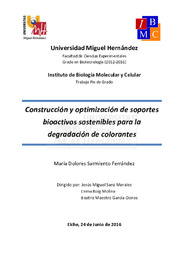Por favor, use este identificador para citar o enlazar este ítem:
https://hdl.handle.net/11000/3545Registro completo de metadatos
| Campo DC | Valor | Lengua/Idioma |
|---|---|---|
| dc.contributor.advisor | Sanz Morales, Jesús Miguel | - |
| dc.contributor.advisor | Roig Molina, Emma | - |
| dc.contributor.advisor | Maestro García-Donas, Beatriz | - |
| dc.contributor.author | Sarmiento Ferrández, María Dolores | - |
| dc.date.accessioned | 2017-04-10T10:17:03Z | - |
| dc.date.available | 2017-04-10T10:17:03Z | - |
| dc.date.created | 2016-07-12 | - |
| dc.date.issued | 2017-04-10 | - |
| dc.identifier.uri | http://hdl.handle.net/11000/3545 | - |
| dc.description.abstract | La construcción de soportes bioactivos, capaces de degradar colorantes empleados en la industria textil, supone una estrategia prometedora para la eliminación de estos compuestos en las aguas residuales producidas tras el proceso de teñido, consiguiendo disminuir su efecto perjudicial en el medio ambiente. En este trabajo hemos evaluado un soporte como es el PHB (polihidroxibutirato), polímero biodegradable y amistoso con el medio ambiente. Sobre el PHB se ha inmovilizado la enzima CueO, de Escherichia coli, mediante un tag de afinidad denominado BioF, que permite su unión al soporte. La enzima BioF-CueO inmovilizada es capaz de degradar colorantes de forma óptima en varias condiciones de pH y temperatura. Con el fin de asegurar que la enzima degrada de manera óptima se ensaya, en el presente trabajo, el efecto sobre la actividad de componentes de los que pueden afectarle (CuSO4, ácido acético, etc), a demás a qué rango de temperaturas se puede trabajar con la enzima inmovilizada y si se puede utilizar un extracto bacteriano sobreexpresando BioF-CueO en lugar de la enzima purificada, para de esta forma, conseguir disminuir costes a la industria. Además, se probó si la actividad de la enzima inmovilizada se veía disminuida tras varios usos. | es |
| dc.description.abstract | Bioactive building supports, capable of degrading dyes used in the textile industry, is a promising strategy for the elimination of these compounds in the wastewater produced after the dyeing process, achieving the reduction of its detrimental effect on the environment. In this work we have tested as a support a biodegradable polymer called PHB (polyhydroxybutyrate), on which the CueO enzyme, Escherichia coli, was immobilized through an affinity tag called BioF, allowing its attachment to the support. The BioF-CueO immobilized enzyme is able to degrade dyes in a variety of pH and temperature conditions. In order to ensure that the enzyme degrades optimally this work tests, the effect of several components (CuSO4, acetic acid, etc.) on the enzyme activity, as well as, at what temperature range the immobilized enzyme can work and if a bacterial extract overexpressing BioF-CueO could be used instead of the purified enzyme, to achieve, in this way, lower costs to industry. Furthermore, it was tested whether the activity of the immobilized enzyme could be decreased after several uses. | es |
| dc.format | application/pdf | es |
| dc.format.extent | 31 | es |
| dc.language.iso | spa | es |
| dc.rights | info:eu-repo/semantics/openAccess | es |
| dc.subject | Polihidroxibutirato | es |
| dc.subject | Colorantes | es |
| dc.subject | Textil | es |
| dc.subject.other | CDU::5 - Ciencias puras y naturales::57 - Biología::577 - Bioquímica. Biología molecular. Biofísica | es |
| dc.title | Construcción y optimización de soportes bioactivos sostenibles para la degradación de colorantes | es |
| dc.type | info:eu-repo/semantics/bachelorThesis | es |

Ver/Abrir:
Sarmiento Ferrandez, MariaDolores .pdf
1,86 MB
Adobe PDF
Compartir:
 La licencia se describe como: Atribución-NonComercial-NoDerivada 4.0 Internacional.
La licencia se describe como: Atribución-NonComercial-NoDerivada 4.0 Internacional.
.png)